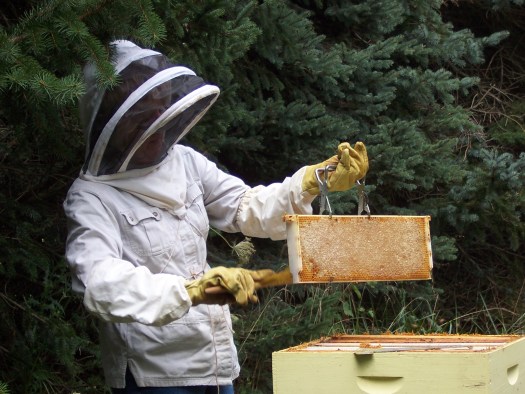
A Honey of a Good Book
I don’t know how I missed the publication of this book in April of 2011 but picked it up at a local plant nursery to look at and was enthralled. As a practicing beekeepr, I get a lot of information off the web and have several beekeeping books on my shelf for reference, such as Beekeeping for Dummies. But this book, The Beekeeper’s Bible, caught my attention and I plunked down the money and bought it. The blurb on the back says that “it is the essential and comprehensive handbook for every active or aspiring beekeeper”.
It is called the ‘bible of beekeeping’ with reason. It is a veritable tome of information measuring 2 1/2 inches thick, and chock-a-block full of interesting bee lore, history, and practical uses. The pages are thick and glossy and richly illustrated.
I would recommend it for beginning beekeepers- maybe ones who have just started, or are teetering on the edge of keeping bees. The book might get you started on the adventure of beekeeping with solid advice, pictures, and recipes. The pictures are stellar, the recipes excellent, and the information comprehensive. Even non-beekeepers will find a wealth of information such as learning about the poisonous honey produced by the nectar of the rhododendron flower, or a recipe for an all natural hang over cure!
There are literally hundreds of historical color etchings and photos interspersed throughout the book which are incredibly detailed, like one with varroa mites feeding on developing bee pupae, and they are quite beautiful. The section illustrating seasonal blooming plants for bees to create a bee-friendly garden is comprehensive would be interesting to non-beekeepers also. I have already tried one of the unusual honey recipes, Endive, Pancetta, and Honey Broiled Fig Salad, which was delicious. I am anxious to try the Apple, Honey, and Chile Chutney when apple season rolls around.
I found interesting the pictures of various shades of honey and charts that describe the various honey’s country of origin, name, color, flavor, etc. Also each type of honeybee is illustrated and has its own page, dedicated to its traits, geographical origins and behavior patterns. You will also learn that honeybees are the only bees that sting in defense and wasps use their stings as weapons of attack. So, remember that, next time you get a sting!

If you want to own just one comprehensive reference book for beekeeping, this is the one for you!



I love old books like this – treasures sparkling with wisdom, and recipes too! Thanks for sharing 🙂
My daughter and I have inherited two hives and want to get started.Where can we obtain a copy
of the Beekeepers Bible and how much?- tony@polyscope.co.za many thanks.
Amazon!